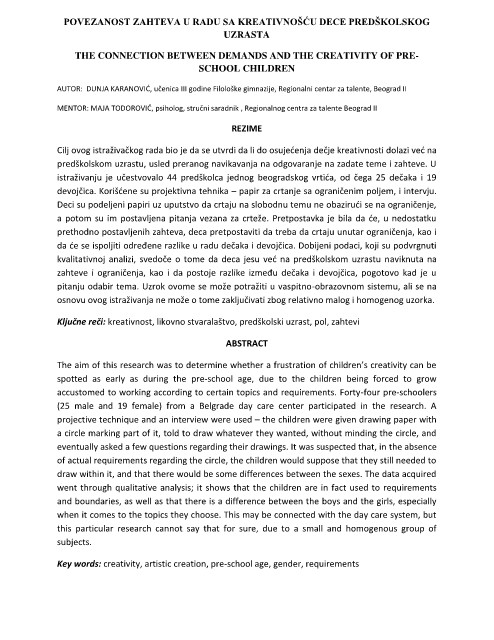Page 429 - Srednje skole - radovi
P. 429
POVEZANOST ZAHTEVA U RADU SA KREATIVNOŠĆU DECE PREDŠKOLSKOG
UZRASTA
THE CONNECTION BETWEEN DEMANDS AND THE CREATIVITY OF PRE-
SCHOOL CHILDREN
AUTOR: DUNJA KARANOVID, učenica III godine Filološke gimnazije, Regionalni centar za talente, Beograd II
MENTOR: MAJA TODOROVID, psiholog, stručni saradnik , Regionalnog centra za talente Beograd II
REZIME
Cilj ovog istraživačkog rada bio je da se utvrdi da li do osujedenja dečje kreativnosti dolazi ved na
predškolskom uzrastu, usled preranog navikavanja na odgovaranje na zadate teme i zahteve. U
istraživanju je učestvovalo 44 predškolca jednog beogradskog vrtida, od čega 25 dečaka i 19
devojčica. Korišdene su projektivna tehnika – papir za crtanje sa ograničenim poljem, i intervju.
Deci su podeljeni papiri uz uputstvo da crtaju na slobodnu temu ne obazirudi se na ograničenje,
a potom su im postavljena pitanja vezana za crteže. Pretpostavka je bila da de, u nedostatku
prethodno postavljenih zahteva, deca pretpostaviti da treba da crtaju unutar ograničenja, kao i
da de se ispoljiti određene razlike u radu dečaka i devojčica. Dobijeni podaci, koji su podvrgnuti
kvalitativnoj analizi, svedoče o tome da deca jesu ved na predškolskom uzrastu naviknuta na
zahteve i ograničenja, kao i da postoje razlike između dečaka i devojčica, pogotovo kad je u
pitanju odabir tema. Uzrok ovome se može potražiti u vaspitno-obrazovnom sistemu, ali se na
osnovu ovog istraživanja ne može o tome zaključivati zbog relativno malog i homogenog uzorka.
Ključne reči: kreativnost, likovno stvaralaštvo, predškolski uzrast, pol, zahtevi
ABSTRACT
The aim of this research was to determine whether a frustration of children’s creativity can be
spotted as early as during the pre-school age, due to the children being forced to grow
accustomed to working according to certain topics and requirements. Forty-four pre-schoolers
(25 male and 19 female) from a Belgrade day care center participated in the research. A
projective technique and an interview were used – the children were given drawing paper with
a circle marking part of it, told to draw whatever they wanted, without minding the circle, and
eventually asked a few questions regarding their drawings. It was suspected that, in the absence
of actual requirements regarding the circle, the children would suppose that they still needed to
draw within it, and that there would be some differences between the sexes. The data acquired
went through qualitative analysis; it shows that the children are in fact used to requirements
and boundaries, as well as that there is a difference between the boys and the girls, especially
when it comes to the topics they choose. This may be connected with the day care system, but
this particular research cannot say that for sure, due to a small and homogenous group of
subjects.
Key words: creativity, artistic creation, pre-school age, gender, requirements

